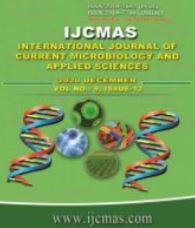


 National Academy of Agricultural Sciences (NAAS)
National Academy of Agricultural Sciences (NAAS)

|
PRINT ISSN : 2319-7692
Online ISSN : 2319-7706 Issues : 12 per year Publisher : Excellent Publishers Email : editorijcmas@gmail.com / submit@ijcmas.com Editor-in-chief: Dr.M.Prakash Index Copernicus ICV 2018: 95.39 NAAS RATING 2020: 5.38 |
The present study was aimed towards investigating the food application of processed mustard meal (PMM), which was obtained through a microwave-assisted processing for reduction of selected anti-nutrients, in a supplementary food (panjiri). During formulation of panjiri, the whole wheat flour was progressively replaced (0-20%) with PMM and the panjiri samples were then evaluated for color, nutritional and sensory acceptability. Panjiri sample with whole wheat flour only was considered as control. Incorporation of PMM decreased the L*, a* and b* value of panjiri from 70.58, 7.43 and 25.32 to 59.74, 5.36 and 17.63, respectively. The total color difference (ΔE) was in the range of 4.13 to 13.46 indicating obvious color changes. The hue and chroma also decreased from 73.65 and 26.39 to 73.09 and 18.43, respectively with increasing PMM level. The sensory evaluation revealed that PMM based panjiri with 5% replacement only was statistically similar to control in overall acceptability. However, the product was acceptable up to 10% incorporation level (OAA score 7.55) also. Nutritional analysis of most accepted PMM (10%) based panjiri sample indicated 1.44% moisture, 14.64% crude fat, 1.20% total minerals, 9.23% crude protein and 73.48% total carbohydrates. The glucosinolates content was 2.20 μmoles/g defatted sample.
 |
 |
 |
 |
 |